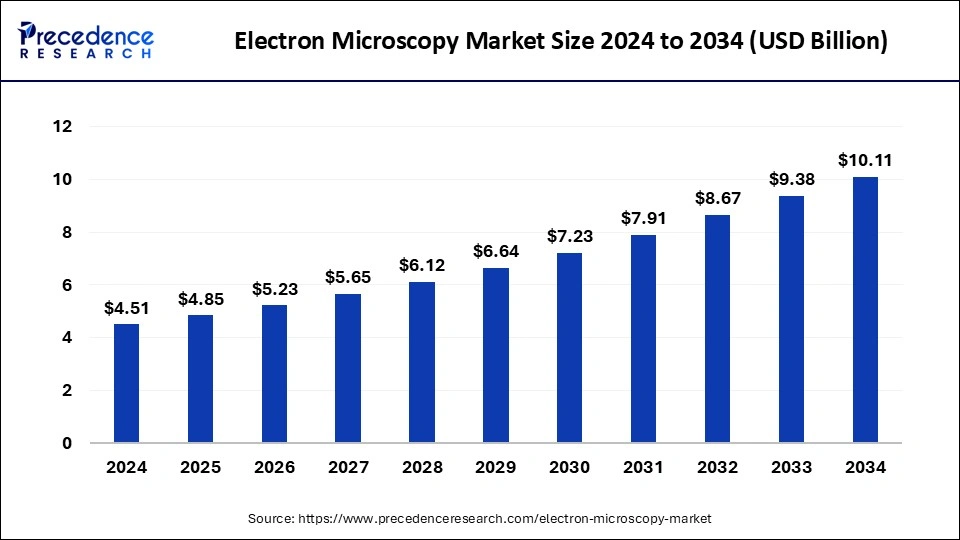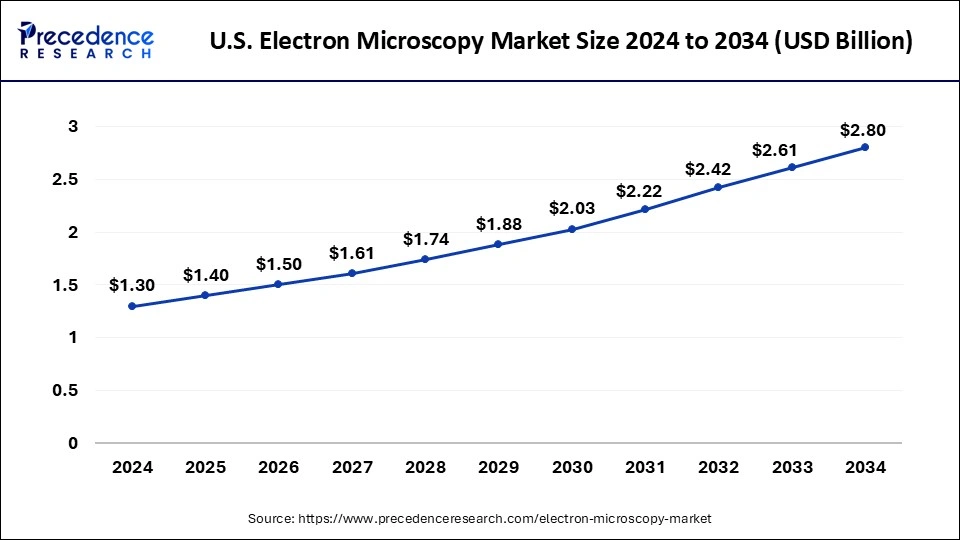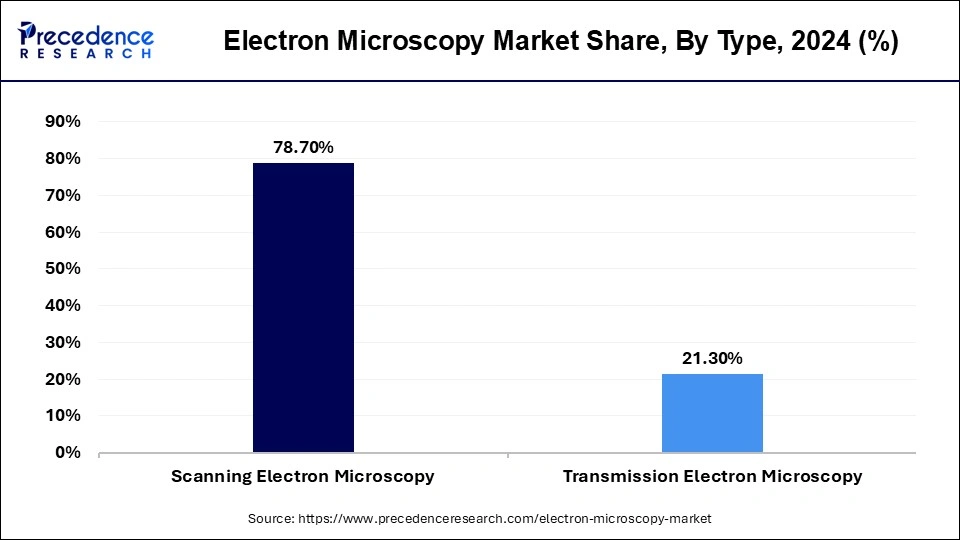January 2025
The global electron microscopy market size accounted for USD 4.85 billion in 2025 and is forecasted to hit around USD 10.11 billion by 2034, representing a CAGR of 8.50% from 2025 to 2034. The North America market size was estimated at USD 16.11 billion in 2024 and is expanding at a CAGR of 7.90% during the forecast period. The market sizing and forecasts are revenue-based (USD Million/Billion), with 2024 as the base year.
The global electron microscopy market size was calculated at USD 4.51 billion in 2024 and is predicted to increase from USD 4.85 billion in 2025 to approximately USD 10.11 billion by 2034, expanding at a CAGR of 8.50% from 2025 to 2034.

The U.S. electron microscopy market size was exhibited at USD 1.30 billion in 2024 and is projected to be worth around USD 2.80 billion by 2034, growing at a CAGR of 8.05% from 2025 to 2034.

North America is a major regional market for scanning electron microscopes. The presence of major players specializing in product innovation, as well as rising expenditure on R&D activities, are driving regional market expansion. Furthermore, the presence of many educational institutions and scientific and technological facilities, particularly in the United States of America, creates a significant opportunity for a growing market.
The expansion of research and development facilities in Europe has benefited this market in the region. The Asia Pacific region is also important in the market, with China, Japan, and India all contributing significantly to market growth. Increased government grants to develop the research and development sector, as well as rising demand for skinny wafers, particularly in the semiconductor industry, are some of the major factors driving market growth in the Asia Pacific region.

Growing demand for nanotech research as well as an increase in funding are key market drivers for electron microscopy. Furthermore, expanding product applications in the electronics and pharmaceutical industries are expected to drive the market during the forecast period. Furthermore, advancements in resolution power and features such as the attachment of other devices, such as an energy x-ray dispersion spectroscope, are expected to drive market growth during the forecast period.
Scanning Electron Microscopes (SEMs) are popular due to their being widely used by small- to medium-sized R&D institutes and pharmaceutical companies. They offer data on surface topography and properties to researchers and quality control personnel, such as topography, chemical analysis, fractography, and so on.
Even though nanotechnology has applications in most areas of semiconductors, material sciences, and life sciences, which have a significant impact on any nation's economy, it encourages government organizations and other corporate enterprises to support R&D through public funding. The global market is expanding due to a variety of factors, including the fact that it is one of the most important devices for analyzing nanomaterials at the atomic scale in many pharmaceutical industries, medical devices, and multiple industrial verticals.
Microscopes are required for procedures such as lithography, coating, failure analysis, and detection in the manufacture of semiconductor devices. The rapid growth of the semiconductor industry in countries such as India and China because of outsourcing of electric manufacturing activities is a driving factor of the SEMs market.
Increased global attention on R&D for applications such as neurosciences, materials engineering, life sciences, nanotechnology, and the semiconductor industry would boost adoption of advanced and automated light microscopy such as scanning probe microscopes, analytical electron microscopes, and SEMs. These microscopes have imaging resolutions of up to 0.1 nm, which is essential for these precision manufacturing industries.
| Report Coverage | Details |
| Market Size in 2025 | USD 4.85 Billion |
| Market Size by 2034 | USD 10.11 Billion |
| Growth Rate from 2025 to 2034 | CAGR of 8.50% |
| Largest Market | North America |
| Base Year | 2024 |
| Forecast Period | 2025 to 2034 |
| Segments Covered | Type, End User, and Application |
| Regions Covered | North America, Europe, Asia-Pacific, Latin America, and Middle East & Africa |
Rising scientific research
Electronic microscopes are frequently used in research labs, academic institutions, and nanotechnology centers. The structure of the sample can be examined in detail in these institutions to learn more about its function. Other bodies, such as industrial companies, can then build on and use the findings of scientific research centers. In a research laboratory, for example, an electron microscope may be used for particle analysis or material characterization. In biomedical research, electron microscopy can be used to investigate the molecular nature and mechanisms of disease, view the 3D structure of biological tissues or cells, determine protein structure, and observe viruses in a biological context. These findings can then be passed on to industry research centers, which will focus on utilizing the data to provide a solution. For instance, information about the nature of the disease could be used to develop medications to manipulate the results.
Higher refining and resolving power
The primary reason driving market expansion is electron microscopes' improved refining and resolving capacity, which provides enhanced output images extending up to several nanometers. Furthermore, the market is expanding because of increased demand for nanotechnology-based devices. Electron microscopes have a higher resolving power than light microscopes. They can see the structure of smaller devices. Electron microscopes are frequently used to investigate the ultrastructure of a variety of biological and inorganic specimens, including cells, microbes such as bacteria, biological macromolecules, biopsy samples, alloys, crystals, and metals. Quality control and analysis can also be performed using electron microscopes. Modern electron microscopes generate electron micrographs by capturing images with digital cameras and frame grabbers.
High production cost
Electron microscopes' high production and upkeep costs are the primary factors limiting their market expansion. Furthermore, the specialized conditions required for proper equipment operation are a major constraint in this industry. Because of technological advancements, people's attitudes towards microscopes have shifted. High-end microscopes, such as electron microscopes, scanning probe microscopes, and digital microscopes, are gradually losing favor with conventional microscopes due to their advanced features, higher resolution, and magnification power. However, the prices for these microscopes range from USD 25,000 to USD 2 million, making them prohibitively expensive for hospitals, pathologist laboratories, and small companies.
Rising technological advancement
The rapid advancement of nanotechnology is propelling the scanning electron microscope market forward. The growing consumer desire for smaller, more efficient devices at lower prices, combined with the growing demand for product miniaturization, has accelerated the development of nanotechnology in a variety of industries. Furthermore, the use of electron microscopes enables the creation of three-dimensional images in a variety of industries. Based on precise images, manufacturers can select optimal manufacturing materials, ensuring product stability and durability. These factors are anticipated to drive market growth during the forecast period.
The rising prevalence of various chronic diseases is expected to increase the demand for advanced R&D activities. As a result of the increased demand for R&D and funding, infrastructure in healthcare and other industries is improving. As a result, the growing number of laboratories in academic institutions and industries such as semiconductors and material sciences, among others, is expected to drive demand for scanning electron microscopes. The increasing use of scanning electron microscopes to review surface morphology and properties such as topography, fractography, and qualitative analysis, among other things, will support market growth.
Technology advancements in scanning electron microscopes enable the generation of data in digital form, which speeds up the instrument's operation. It also reduces the number of steps required for sample preparation. These factors are expected to contribute to the overall growth of the market during the forecast period.
The electron microscopy market is divided into three categories: type, application, and end user. The increased use of electron microscopes in research and manufacturing processes is a major driving force in the global electron microscopy market. Furthermore, electron microscopes are widely used in the field of semiconductor materials for circuit editing and analyzing circuit failure, which significantly increases their demand and, as a result, the electron microscopy market growth.
Furthermore, they are used in clinical trials, pathology, diagnosis of diseases, toxicology, and a variety of other sub-disciplines in the life sciences. Electron microscopy can also be used to characterize materials, study their internal structures, and for a variety of other purposes. It is also used in food, forensics, healthcare, chemical and other industries. The commercial and industrial sectors have high growth potential in the electron microscopy market.
Furthermore, the electron microscopy market opportunity exists in food, forensics, chemical, healthcare, and other industries. According to the latest developments in electron microscopy, the most widely used technologies are immune electron microscopy and cryo-electron microscopy. The electron microscopy industry is expected to grow progressively in the forecasted period due to increased demand for these technologies.
The scanning electron microscopes dominate the electron microscopy market. The scanning electron microscope segment contributed the most revenue to the market and is expected to grow at a healthy CAGR due to an increase in demand for nanotechnology-based research. In medical science, SEMs are used to compare blood and tissue samples to determine the cause of illness and measure the effects of treatments on patients (while contributing to the design of new treatments). Typical applications include recognizing diseases and viruses, new vaccines and medicines being tested, and comparing tissue samples from patients in a control and test group testing samples over a patient's lifetime.

Electron Microscopy Market Revenue, By Type, 2022-2024 (US$ Million)
| Type | 2022 | 2023 | 2024 |
| Scanning Electron Microscopy | 3,093.5 | 3,308.8 | 3,552.4 |
| Transmission Electron Microscopy | 849.1 | 901.9 | 961.5 |
In 2024, the life science segment dominated the overall market, accounting for more than 25.02% of total revenue. Some of the factors contributing to the segment's large market share include the increasing prevalence of chronic diseases, which has led to increased R&D expenditure and demand for digital microscopes in the fields of life sciences and medicine. Life science, material science, nanotechnology, semiconductors, and other application segments are among those being studied in the industry.
Electron Microscopy Market Revenue, By Application, 2022-2024 (USD Million)
| Application | 2022 | 2023 | 2024 |
| Lifesciences | 991.5 | 1,053.5 | 1,123.6 |
| Material Sciences | 884.9 | 949.7 | 1,023.1 |
| Semiconductors | 1,446.8 | 1,543.6 | 1,653.0 |
| Nanotechnology | 391.8 | 423.8 | 460.0 |
| Others | 227.6 | 240.1 | 254.1 |
Material science was the second-largest end-use segment overall. SEM has become an established characterization tool in materials science. In materials science, SEMs are used for quality control, research, and failure analysis. Investigation and research on nanofibers and nanotubes, high mesoporous architecture, temperature superconductors, and alloy strength are all heavily reliant on nanofibers and nanomaterials.
By Type
By End User
By Application
By Geography
For inquiries regarding discounts, bulk purchases, or customization requests, please contact us at sales@precedenceresearch.com
No cookie-cutter, only authentic analysis – take the 1st step to become a Precedence Research client
January 2025
December 2024
October 2024
July 2024